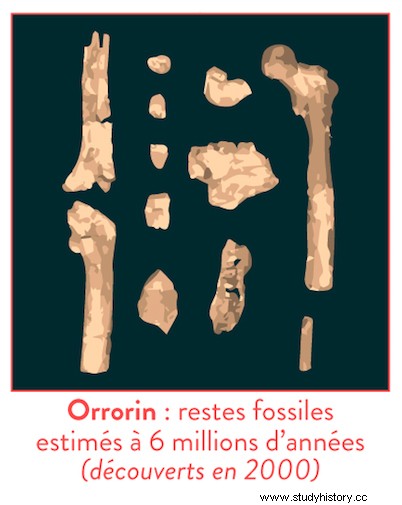In Tugen Hills, in the heart of Kenya, in the Lukeino deposit, north of Ecuador, a molar was discovered in 1974 by paleontologist Martin Pickford. But, in the absence of other clues, there is no certainty that it belongs to a hominid rather than an ape.
2000

Characters
Ezra Kiptalam Cheboi
Martin Pickford
Brigitte Senut
Procedure
Paleontologists are patient. Excavations resumed in 1998 at the initiative of the Kenyan government, almost twenty-five years later, led by the same paleontologist, accompanied by Brigitte Senut, in collaboration with community museums in Kenya. Twelve years later, in the fall of the year 2000, Ezra Kiptalam Cheboi, during the expedition still led by the close collaboration between Kenya and France (Kenya Palaeontology Expedition ) discovered numerous fossils at four sites, Aragai, Cheboit, Kapcheberek, Kapsomin, in the Lukeino deposit. Some bones were covered with a particle of travertine (a type of limestone rock), sprinkled by the hot waters that then gushed out. This time, research confirms that it is five hominids, 6 million years old. The scientific world is turned upside down!
Named Orrorin Tugenensis, Orrorin, derived from the name of a mythical character of the region, means "original man". His partially recomposed skeleton was very quickly nicknamed "Millenium Ancestor" or "ancestor of the millennium". He therefore supplants Lucy as the oldest hominid found by more than 3 million years, and reverses the theories that we had on the origins of the first men! If the humerus and the phalanx underline the still arboreal way of life (life in the trees), on the other hand, the shape of the femur betrays a bipedal position. It would measure around 1.20 m and weigh between 30 and 50 kg. Based on the marks on the bones, a carnivorous feline was most likely responsible for Orrorin's death. In addition, if many bones were discovered around, no tool was found. Unlike Lucy, the oldest ancestor found, Orrorin would not be an Australopithecus, but would indeed be of the “homo” species and our direct ascendant.
Consequences
Each new hominid discovered pushes the knowledge of paleontology on the ancestors of modern man. The more research advances, the more it upsets the knowledge we have of the first men. Thus the discovery of Orrorin confirms that the divergence between the great apes and the hominid species to which it belongs occurred before the 6 million years, date of its existence, contrary to the theories put forward until then. A year later, the discovery of Toumaï will confirm that this knowledge is constantly to be questioned.
